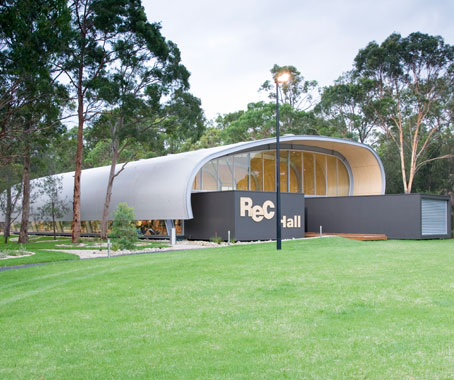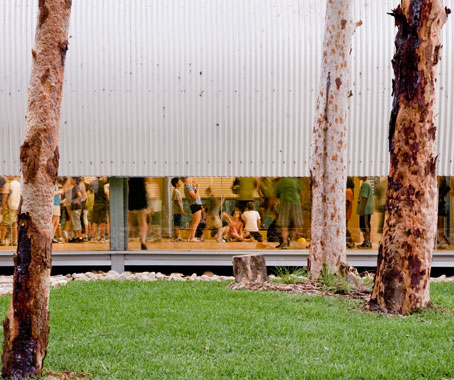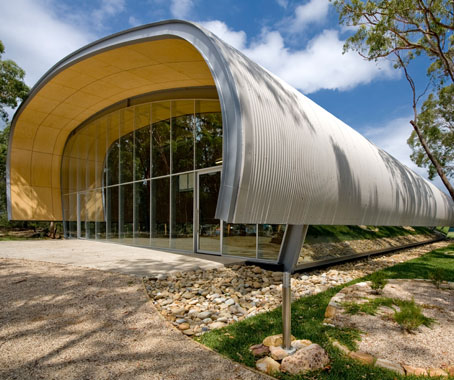This new aerodynamic sports hall takes its inspiration from its surrounds, writes Rob Gillam.
April 11th, 2012
When Allen Jack+Cottier principal, Michael Heenan, first walked on to Milson Island to begin the process of designing a sport and recreation hall, he did so without preconception.
Instead, he carefully considered the site conditions and allowed these to shape the building.
Aerodynamic analysis revealed that the channel carved through the spectacular sheer rock faces by the Hawkesbury River bends the breeze up and over the island.
“So, we designed the building shape to react to this more constant breeze,” says Heenan. “We knew we had the opportunity to harness it for natural ventilation.”

The wing-shape of the roof creates suction, which is used to draw hot air out of the building through roof turbines, creating an internal cooling effect.
Air is drawn into the building through low-level louvres, which run the length of the building, and over large shaded and moist river stones that enhance the cooling effect.

Heenan pushed hard to place the hall amongst bushland rather than in a clearing, in order to camouflage it from the adjacent Milson’s Passage residents.

The building’s roof design, which extends toward the ground, becomes a protective shell and fire deterrent skin, wrapping the entire building.
The roof also deflects tree debris, which collects on the ground alongside an in-ground rainwater gutter that lies beneath a filtering stone garden.
The design was enough to extinguish fire hazard concerns and the hall nestles deeply into a thick clump of trees.

Photography: Nic Bailey
Read the full story on Milson Island Indoor Sports Stadium in Indesign #48, out now.
Allen Jack+Cottier
architectsajc.com
INDESIGN is on instagram
Follow @indesignlive
A searchable and comprehensive guide for specifying leading products and their suppliers
Keep up to date with the latest and greatest from our industry BFF's!

London-based design duo Raw Edges have joined forces with Established & Sons and Tongue & Groove to introduce Wall to Wall – a hand-stained, “living collection” that transforms parquet flooring into a canvas of colour, pattern, and possibility.
The new range features slabs with warm, earthy palettes that lend a sense of organic luxury to every space.

A curated exhibition in Frederiksstaden captures the spirit of Australian design

For Aidan Mawhinney, the secret ingredient to Living Edge’s success “comes down to people, product and place.” As the brand celebrates a significant 25-year milestone, it’s that commitment to authentic, sustainable design – and the people behind it all – that continues to anchor its legacy.
When you think of light, concrete is probably not the first thing that comes to mind. As part of the new Aeon Illumination™ collection, the light fittings incorporate honest materials to create a resolved design.
The internet never sleeps! Here's the stuff you might have missed

Whether you’re an architect, interior designer or student eager to learn, the 2025 Design Discussion series at Saturday Indesign will inspire fresh perspectives. Check out the schedule now!

Jesse Lockhart-Krause, Director of Lockhart-Krause Architects, tells us about a storied building in Queensland that has now become a functional workplace for a therapy centre.